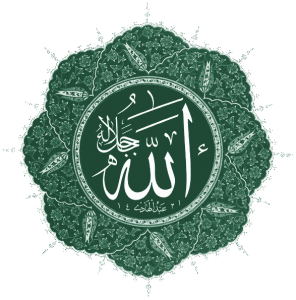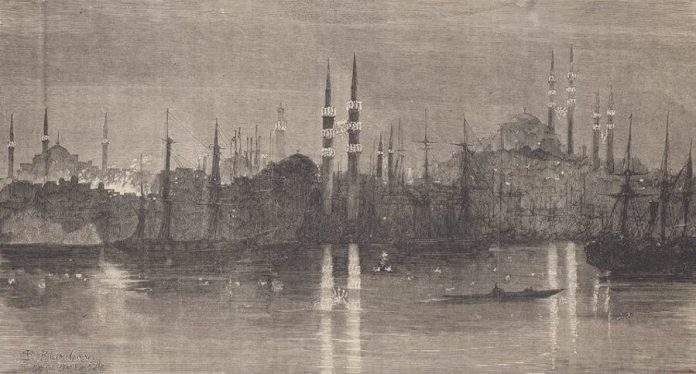 In Islam, there is a custom called Kandil ( Feast in English). These are periodic religious observances commemorating an event, or honouring a Deity, a person or a thing. There are four such events in Islam that are considered Holly. They are observed regularly with solemnity. Those are Mevlud, the celebration of the Birth of Muhammed, Regaib that glorifies His Conception, Mirac that praises His Ascension to Heaven, and Berat that observes His investiture with Prophet-hood. In those occasions, the devout are reminded of their pious obligations towards Providence as well as their social obligations to fellow human beings. The believers are enjoined to reflect and pray, to concentrate on their inner world, and to become more mindful of their relationship with God. To add a measure of festivity to those observations the bakeries make special bagel-type rolls, and the mosques are lighted up. The devout are encouraged to read and chant Qur’an. Families, friends and relatives pay visit to each other.
In Islam, there is a custom called Kandil ( Feast in English). These are periodic religious observances commemorating an event, or honouring a Deity, a person or a thing. There are four such events in Islam that are considered Holly. They are observed regularly with solemnity. Those are Mevlud, the celebration of the Birth of Muhammed, Regaib that glorifies His Conception, Mirac that praises His Ascension to Heaven, and Berat that observes His investiture with Prophet-hood. In those occasions, the devout are reminded of their pious obligations towards Providence as well as their social obligations to fellow human beings. The believers are enjoined to reflect and pray, to concentrate on their inner world, and to become more mindful of their relationship with God. To add a measure of festivity to those observations the bakeries make special bagel-type rolls, and the mosques are lighted up. The devout are encouraged to read and chant Qur’an. Families, friends and relatives pay visit to each other.
There is a vague reference in history that attributes the beginning of this custom to Sultan Selim I (Yavuz or Grim, 1512-1520). There may be some truth to that as all of his wars were against the Arabs (Memluks) or Persians (Safavids). He also brought Khilafet to the Ottomans from Egypt in 1516. One of Istanbul’s imperial mosques, the world famous Sultan Ahmed Mosque (Blue Mosque) was completed in 1616, and during its dedication ceremony the Ottoman sultan Ahmed I (1603-1617) initiated a custom of stringing oil lamps (Kandil) high in the air among the six minarets. This type of illumination is called “Mahya”. Kandil is a generic term that refers to the above four special events, it is a reference to those illuminations. Nowadays, however, the oil lamps have been replaced by electric bulbs. Those Mahyas occasionally spell out greetings and goodwill messages which could be seen at nights from everywhere. These illuminations are made throughout Ramadan also. The most popular message is “HOS GELDIN YA MUBAREK RAMAZAN” (Welcome, O Sacred Ramadan). Those lights remain the entire month of celebration, including the Feast of Ramadan, the three-day observance marking the end of the fasting.
Lately, those Kandil celebrations have come under scrutiny. The contemporary scholarship claims that they did not exist during the time of Muhammed. There is no reference to such customs in the Holy Qur’an either. Also, during the period of the four Khalifs (Rashidun) who ruled after Muhammed, no such tradition was ever observed. Later on, as the Muslim community started to grow, it has become more diverse, and to control the masses and bringing them into submission presented a challenge for the rulers. The Ulama came up with the idea of using religious observances to control the masses. The mosques have always been a perfect setting for the rulers to showcase their power. People are attracted to mosques where they are made subject to a massive brain-washing. They are induced to turn to their inner world with the inspiration of the ever-present heavenly fear. In the imposing atmosphere of the mosque, the collective sub-conscious becomes imbued with the supremacy and the Might of the God as well as His Regent, the ruler. The serenity of the mosque and the unruffled quietude make the believer mentally ready for initiation into submission and obedience to God.
The devout in the congregate feel humble and diminished. Once people are thus tamed, the allegiance to the ruler is hammered home. The message that comes across is loud and clear. “Obey the God, and obey His shadow on earth,” This is a guided rite of passage into indoctrination and resignation. It all boils down to controlling the masses, and the Kandils have proven perfect medium to achieve this. The real purpose of those observations is political; religion is but a sugar-coating. Then the bottom line is, Kandils are temporal events, and later inventions and accretions to Islam by the clergy; they are not divinely ordained.
In fact, modern scholars dispute the occasions that putatively gave rise to Kandil celebrations. For instance, they say in an ever-changing Islamic lunar calendar system how reliable is the date of birth of Muhammed, let alone his Conception? How so intimate an event could have been chronicled, and 1500 years ago at that? Besides, how significant is this, and what is its relevance to His holiness? Also, there are question marks about the Mirac Kandil which celebrates His Ascension to Heaven. The legend has it that He mounted a charger called “Burak”, journeyed to “seventh” heaven and met with God. He travelled from Mekka to Jerusalem – on a camel back – and returned on the same night. The distance covered is about 1000 miles, not to mention His vertical journey to Heaven. The modern scholars say these are parables, and today people regard them just fairy tales. Therefore, all the Kandil literatures which we see in print these days are mythical lore, not authentic.
We are living in an age of query. With the onset of the internet age, everything is debated and probed, and logical answers are sought. Islam, so far, has remained immune from this brutal dissecting process. Yet, lately, some fertile minds (shall we call them “iconoclasts!”) courageously search explanations to age-old taboos in Islam within the framework of reason.
*******
Pennington, NJ
6th February 2012

